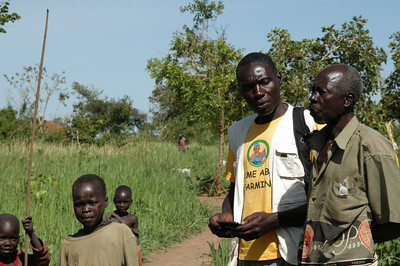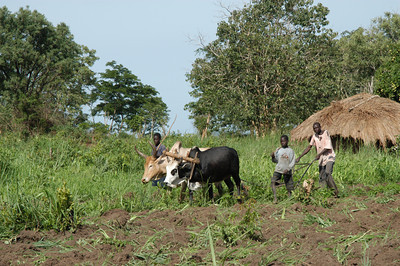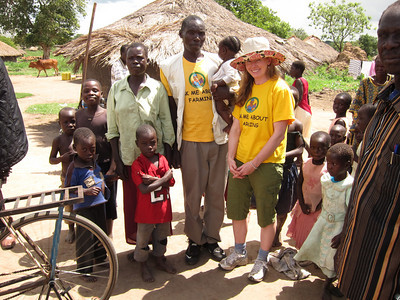Grameen Foundation’s Sean Krepp and Dr. Olga Morawczynski recently published this paper on Saving on the Mobile in the World Economic Forum’s Mobile Financial Services Development Report 2011.
Savings on mobile money
A recent survey of over 2,000 Kenyan households found that 89% of respondents used M-PESA, a Kenyan mobile money (MM) application, “to save” (Suri and Jack, 2010). Dr. Morawczynski confirmed this finding after spending over 18 months studying the financial habits of resource poor M-PESA users in two locations: an urban slum called Kibera and village in Western Kenya called Bukura (Morawczynski, 2010). The study found that M-PESA was integrated into the financial portfolios and acted as a complement, rather than a substitute, to other mechanisms. This paper expands on these findings by disaggregating the term “savings” and focusing on behavior.
Four scenarios have been developed to explain how and why resource poor individuals use MM as a savings mechanism. These scenarios describe the frequency of transactions and the costs associated with each form of savings. A case study accompanies each scenario to explain the circumstances leading to the savings behavior.
Two MM applications are central to this analysis— M-PESA in Kenya and MobileMoney in Uganda. Product ideas are derived from analysis of practices. To “go beyond payments” and be relevant to poor users, mobile applications must be designed to fit into existing practices rather than trying to change or displace them.
Savings scenarios
Most survey respondents adopted MM to send or receive money. MM provided one of the fastest, and cheapest, methods of money transfer. Before MM was introduced, many respondents had to leave their villages to collect cash transferred by bus or via the post office. These trips were expensive, costing up to 30% of the amount received. However, after users became accustomed to MM services, many started using MM for savings. As one Kenyan farmer explained:
I signed up at first because my brother was sending me cash from Kisumu. I would also use M-PESA to send to my mother. Then the agent told me that M-PESA is also like a bank. I can save my money there and withdraw it when I need it.
There are several ways individuals “saved” on their MM accounts, also known as wallets. The following four savings scenarios are derived from interviews with respondents as well as financial diaries, which tracked respondents’ inflows and outflows for a month:
Scenario 1: Saving to Transfer
Some savers use MM to accumulate cash before transferring the value to a recipient. In most cases, the senders predetermined the amount they wanted to send and saved through small deposits until the target was met. This form of savings is often inexpensive for the users because deposits are free. In this scenario, MM is a dedicated account for remittances and facilitates the separation and organization of savings, allowing users to control their spending. As one security guard explained, “If the cash is not on hand then I can’t waste it”. It also allows the users to use the check balance function to track their progress, and know how much more they need before sending off the cash. Some also explained that this form allows them to “top-up” their balance. Topping up allows savers to meet their targets more quickly.
Paul, Mechanic and shop owner in Kibera, Kenya
Paul is a mechanic in Kibera, a slum near Nairobi. Paul also owns a small retail shop, at which he works during the evenings. He stays alone in Kibera, but supports his mother and three children who live in Bukura, a small village in Western Kenya. His wife died five years ago and his mother takes care of the children while he works in the city.Paul sends the equivalent of US$ 46 (4,000 KES) per month. This money is mainly used by his mother to purchase items such as milk, sugar, and porridge. Paul explains that the rising costs of city life make it difficult to meet the target. To organize his savings, he made a savings plan and started to deposit US$ 6 (500 KES) every week. This allows him to save half (2,000 KES) of what he needs to transfer each month. The other half is “topped up” by clients who purchase goods on credit from his shop and pay him the balance at the end of the month. After meeting the US$ 46 target, Paul makes the transfer to his mother and starts saving once again.
Customers engaging in this form of savings usually deposited on a weekly, or bi-weekly, basis and held the balance for one to two months. They would deplete their balance when sending money and thereafter start to build up their balance from zero. As shown below, this form of savings did not incur too many transaction costs. Paul was only charged when he transferred his savings balance to his mother.
Scenario 2: Saving down after receiving cash
In many of the rural villages, recipients engage in another form of savings behavior—“saving down”. They receive cash from relatives and withdraw the money in small increments until the balance is depleted. Many individuals who engage in this form of savings do not have a formal bank or microfinance institution account. They want to keep cash outside of the home for emergencies and to curb their temptation to spend the savings.
Moses, motorcyle taxi driver in Kyenjojo, Uganda
Moses lives in a small village in Western Uganda. He works mainly as a motorcycle taxi driver and also has a small plot of land that he farms. He has a sister living in Kampala, Uganda’s largest city, who sends him cash at least twice a year to help boost his business. He uses that cash to purchase petrol or spare parts for his bike. Moses does not withdraw the cash after receiving the transfers because his sister usually sends a sizeable amount of cash (US$ 100 USD or 200,000 UGX). The agent usually does not have the cash float to handle a total withdrawal at one time. Instead, Moses takes out cash when he needs it and maintains a balance on his MobileMoney account. When his business earnings are good he makes deposits to increase his balance. Having available cash helps Moses deal with emergencies.
This form of savings is more expensive than the first scenario. The customer is charged a fee for each withdrawal transaction; the fee depends on the amount withdrawn as the pricing structure is tiered. This form of savings is cheaper than travelling to the nearest urban area to access banking service as the trips cost from US$ 2.00-$15.00 according to the research sites. In this scenario, the recipients often make withdrawals on a bi-weekly basis. They usually keep at least a small balance on the MM wallet until they receive the next transfer. This form of savings is especially appropriate for those who receive cash from several urban contacts. Their savings are often “topped up” without having to make a deposit.
Scenario 3: Transactions Account
Some respondents make frequent small deposits and withdrawals, using the MM wallet like a transactions account. In this scenario, transactions are more frequent and it is common for the wallets to reach a zerobalance. In some cases, those engaging in this form of savings are traders and micro-entrepreneurs.
Grace, clothes trader in Kiyindi, Uganda
Grace owns a small clothes trading business. She travels weekly to the nearest town center to purchase clothes, and bring the items back to resell in her village on market day. Grace opened up a mobile money account last year for safety reasons. She often travels with large amounts of cash and does not want to be robbed. She deposits cash before making her trip to town, and withdraws it when she arrives. Grace see great value in using MM for business purposes. For example, she sends cash to the clothing dealers in town in early morning to secure the best items of clothing. She accepts payments from customers who purchase clothing in bulk.
users because deposits are free. In this scenario, MM is
a dedicated account for remittances and facilitates the
separation and organization of savings, allowing users to
control their spending. As one security guard explained,
“If the cash is not on hand then I can’t waste it”. It also
allows the users to use the check balance function to
track their progress, and know how much more they
need before sending off the cash. Some also explained
that this form allows them to “top-up” their balance.
Topping up allows savers to meet their targets more
quickly.
Customers engaging in this form of savings usually
deposited on a weekly, or bi-weekly, basis and held the
balance for one to two months. They would deplete
their balance when sending money and thereafter start
to build up their balance from zero. As shown below,
this form of savings did not incur too many transaction
costs. Paul was only charged when he transferred his
savings balance to his motherGrace owns a small clothes trading business. She travels weekly to the nearest town center to purchase clothes, and
Before signing up for MM, Grace kept most of her cash in a small box hidden in some pots at home. She used this form of savings because the cash was easy to access. Recently, her husband found the money and spent it on alcohol. Grace had to stop trading for over two weeks because she lacked cash to purchase clothing. After the incident, Grace moved the cash at home to her MM wallet, which she uses as her business account. She also opened a bank account in town to accumulate her profits. If she maintains a balance, she hopes to secure a loan to grow her business.
These users often send and receive money from business contacts. They make withdrawals to pay expenses or to invest in their businesses. Some use cash in MM for daily consumption. They make deposits when they have cash and withdrawals when needed. Although such withdrawals were costly, many engage in this form of savings because they do not want to keep cash at home. As the case study shows, money stored at home is prone to theft by a thirsty spouse. Some respondents use MM in this manner because banks are too costly for frequent and small transactions. Cash can be accessed from a network of agents, which allows users to travel without having to carry cash.
Scenario 4: Targeted Savings
Some respondents use the MM wallet to save for a particular goal, such as land, cattle or school fees. Often, these savers develop a schedule for the frequency and amount of their deposits. Many only withdraw the cash when they meet their targets, unless they have a pressing need. With this form of savings, users keep cash in the wallet for weeks or months.
Oscar, sugar cane farmer in Bukura, Kenya
A few years ago, Oscar’s son suffered an accident and spent nearly five months in the hospital before passing away. Oscar had to sell his land to pay for medical and funeral bills. He eventually secured work at a nearby sugar plantation, which provided him with housing. Oscar wants to repurchase his land because he plans to retire in a few years and needs a place to live.
Recently, Oscar started his savings plan. He needs about US$ 700 to buy back his small plot of land. He earns about US$ 100 per month in his current job and put US$ 60 per month into his mobile money wallet. The sugar plantation has some savings groups, but Oscar prefers to use MM because he wants to put away larger amounts of savings “in secret”. If the other workers found out that he had money, he would be asked for loans. Oscar can track his progress using his phone to check his balance. This has helped him to stay on track with his savings goal.
Many using this form of savings have no access to formal savings mechanisms or find such mechanisms too expensive. One tailor in Kyenjojo, a farming community in Western Uganda, prefers to save in MM for larger purchases even though there is a Savings and Credit Cooperative (SACCO) in his village. The check balance function allows him to keep better track of his savings and “monitor” whether his cash has been stolen. Such monitoring was more difficult with the SACCO because he had to physically go there and wait for a receipt.
Individuals who accumulate savings through frequent deposits have several complaints. First, no interest is offered on MM wallets because they are not designed to be savings accounts. Second, it is often difficult to make large cash withdrawals in rural areas because the agents often run out of cash. Because most transactions in these areas are withdrawals, the agents have to travel to banks to replenish their cash floats. Such trips can be expensive and time-consuming. Some agents limit their trips and spend days without a float.Targeted savings provide one of the cheapest forms of money storage. Individuals are only charged when they make a withdrawal. There is no charge for storing cash in the account.
Product Design
These savings scenarios should inform the design of innovative mobile savings products that serve poor people’s needs. They provide important insights into the what, how and why people use MM as storage and savings tools. These insights have poignant implications for product innovation beyond payment.
Product Scenario 1: Saving to Transfer
Cash accumulation into an e-wallet or “saving up” is more challenging than receiving cash and “saving down” as in Scenario 2. It took Paul one month of careful deposits and collecting his lines of credit to meet his monthly remittance targets. As he lives in an urban setting there is greater temptation to spend on nonessential goods and services. Paul and other savers like him could be incentivized to put their savings into micro-time deposits, which earn interest while savers are depositing towards their targets. If savers build up their deposits and do not withdraw over a given period they could be offered more attractive tiered interest rates, similar to the MM practice of tiered transaction fees. Savers could also be given the option of compartmentalizing the MM wallet to have a dedicated remittance account. This would allow someone like Paul to use MM as both a shortterm storage and a transaction account. Other creative approaches could increase savings balances. For example, a portion of airtime value could be funneled into the account when a top-up is made. Such strategies could help customers like Paul increase the remittance account balance without too much effort. For this to occur, the MM wallet and bank account would have to be linked.
These types of savers could be followed over time to build up credit risk ratings and thus become eligible for credit facilities such as an overdraft, similar to the M-Kesho offering in Kenya.
Product Scenario 2: Saving Down After Receiving Cash
It takes much less effort for customers to deplete their savings balances, or save down, than it does for them to accumulate cash. As in Scenario 2 (saving after receiving), users like Moses only withdraw cash when they need it. This results in far fewer transactions than those in Scenario 1 (saving to transfer) or 4 (targeted savings). A product that funnels a pre-determined portion of cash into a separate account, every time that cash hits the wallet, could support this savings behavior. For example, Moses could opt into a programme that sends 20% of the money received into an interest bearing savings sub-account. This would allow him to maintain a balance for emergencies or business investments and use the money in the wallet for his business. Bulk salary payments could be linked to these types of sub-accounts, as could government poverty payments, providence fund offerings and international remittance payments. This could centralize the cash streams of users, and provide opportunities for the savings sub-account balance to be topped up.
Product Scenario 3: Transactions Account
In Grace’s micro-business she needs liquidity to pay suppliers and transact with customers. She wants to securely store and save larger sums. She also wants to build a credit history so that she can eventually access a line of credit. Providers could consider offering savers like Grace a transaction sub-account that charges both deposit and withdrawal transactions, but keeps the cost of the transactions low compared to banks.. This would facilitate high volume and low-value transactions while allowing mobile operators to increase the amount of cash that goes through the system.
Transaction histories could be monitored to measure credit worthiness. Overdraft facilities or other forms of credit could be offered to low risk customers. These could be modeled after the “pay-later” airtime schemes that are already offered in countries such as Uganda. These allow customers to purchase small amounts of airtime on credit, and pay the interest when they top-up their balances. In this case, interest could be paid when customers receive cash on their wallets. Customers could be allowed to extract their account history, for a small fee, to secure loans from other financial service provider.
Product Scenario 4: Targeted Savings
Oscar and others like him are deliberate in their savings targets. In Oscar’s case, the repurchase of his land was his motivation for systematic savings. Not unlike Paul in Scenario 1, Oscar saved in small increments toward his personal goal, whilst Paul saves to support his mother and children. The key value propositions are flexibility, transparency and personal control over targets. Savers could be empowered to set their savings targets through the mobile interface. This would allow them to decide how much they need to achieve their goals.
Savers could be given full transparency over the amounts saved toward their goals and could be sent reminders to stay on track. Different target levels could be linked to different interest rates and increases in minimum balances could open up new facilities once risk profiles are ascertained.
Targeted savings account products could be marketed to serve common individual or collective savings needs such as group contributions for weddings or funerals. The goal would be marketed rather than the mechanism for getting there.
Conclusion
The industry has given much attention to scaling MM, either through growth of the distribution network or inclusion of a wide partnership base. These discussions have overshadowed those on products. We have forgotten that M-PESA grew quickly because it was appropriate for poor Kenyans, suited their needs and compatible with their financial habits. The expanding agent network and enrollment of many partners facilitated that growth.
If we aim to go beyond payments, attention must be focused not only on what people want, but also on what they do. Numerous empirical studies, including this one, show that poor people store money in a variety of savings devices—from locked boxes to holes in the ground. These studies show that the poor wantsomething different, and are willing to pay for it. This provides a unique opportunity for banks and mobile operators to generate revenues by pulling billions of dollars from these hiding places.
In addition to understanding what people do, we must also focus on why it is important to them. This can cultivate value propositions that resonate with this segment. Nearly every Kenyan understood the three words that guided the launch of M-PESA—“send money home”. Finding propositions that work as well for savings—such as for school fees or business investments—is equally important. This will facilitate the shift of particular markets, as well as the entire MM industry, beyond payments.





